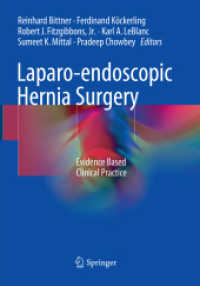- ホーム
- > 洋書
- > 英文書
- > Psychology
Full Description
Motor Control and Learning, Sixth Edition With Web Resource, focuses on observable movement behavior, the many factors that influence quality of movement, and how movement skills are acquired. The text examines the motivational, cognitive, biomechanical, and neurological processes of complex motor behaviors that allow human movement to progress from unrefined and clumsy to masterfully smooth and agile.
This updated sixth edition builds upon the foundational work of Richard Schmidt and Timothy Lee in previous editions. The three new authors—each a distinguished scholar—offer a range and depth of knowledge that includes current directions in the field. The extensively revised content reflects the latest research and new directions in motor control and learning. Additional new features of the sixth edition include the following:
• A web resource that includes narratives and learning activities from Motor Control in Everyday Actions that correspond with the chapters in the book, giving students additional opportunities to analyze how research in motor learning and control can be expanded and applied in everyday settings
• An instructor guide that offers sample answers for the learning experiences found in the student web resource
• New content on sleep and movement memory, the role of vision, illusions and reaching, the OPTIMAL theory of motor learning, the neuroscience of learning, and more
Motor Control and Learning begins with a brief introduction to the field and an introduction to important concepts and research methods. Part II thoroughly covers motor control with topics such as closed-loop perspective, the role of the central nervous system for movement control, speed and accuracy, and coordination. Part III deals with motor learning, exploring the effects of attentional focus, the structure of practice sessions, the role of feedback, theoretical views of motor learning, and the retention and transfer of skills.
Throughout the book, art and practical examples are included to elucidate complex topics. Sidebars with historical examples, classic research, and examples of real-world applications highlight the importance of motor control and learning research and bring attention to influential research studies and pioneers. End-of-chapter summaries and student assignments reinforce important concepts and terms and provide review opportunities. For instructors, an image bank complements the new instructor guide; it is available to course adopters at www.HumanKinetics.com/MotorControlAndLearning.
The updated research, new features, and highly respected authors of Motor Control and Learning, Sixth Edition With Web Study Guide, provide a solid foundation for both students and practitioners who study and work in fields that encompass movement behavior.
Contents
Part I. Introduction to Motor Behavior
Chapter 1. Evolution of a Field of Study
Understanding Movement
Origins of the Field
Summary
Chapter 2. Methodology for Studying Motor Performance
Classification of Motor Skills
Basic Considerations in Measurement
Measuring Motor Behavior
Measuring and Evaluating Relationships
Reliability and Individual Differences
Summary
Chapter 3. Human Information Processing
Information-Processing Model
Three Stages of Information Processing
Anticipation
Signal-Detection Theory
Memory
Summary
Chapter 4. Attention and Performance
Types of Attention
Theories of Attention
Competition for Attention
Attention During Movement
Focus of Attention
Automaticity: The Constrained Action Hypothesis
Attention and Anxiety
Summary
Part II. Motor Control
Chapter 5. Sensory and Perceptual Contributions to Motor Control
Closed-Loop Control Systems
Vision
Audition
Proprioceptors
Proprioception and Motor Control
Feedforward Influences on Motor Control
Summary
Chapter 6. Central Contributors to Motor Control
Open-Loop Processes
Central Control Mechanisms
Central Control of Rapid Movements
Generalized Motor Programs
Summary
Chapter 7. Principles of Speed and Accuracy
Fitts' Law: The Logarithmic Speed-Accuracy Trade-Off
Linear Speed-Accuracy Trade-Off (Schmidt's Law)
Temporal Speed-Accuracy Trade-Off
Central Contributions to the Spatial Speed-Accuracy Trade-Off
Correction Models of the Speed-Accuracy Trade-Off
Summary
Chapter 8. Coordination
Discrete Tasks
Continuous Tasks
A Dynamical-Systems Account of Coordination
Summary
Part III. Motor Learning
Chapter 9. Motor Learning Concepts and Research Methods
Defining Motor Learning
Measuring Motor Learning
Designing Experiments on Learning
Using Alternative Methods to Measure Learning
Understanding Issues About the "Amount" of Learning
Understanding Learning and Performance Variables
Summary
Chapter 10. Conditions of Practice
Verbal information
Focus of Attention
Motivational Influences on Learning
Observational Learning
Mental Practice
Distribution of Practice
Variability of Practice
Contextual Interference
Guidance
Summary
Chapter 11. Augmented Feedback
Classifications and Definitions
Informational Functions of Feedback
Motivational Functions of Feedback
Attentional Focus Functions of Feedback
Theoretical Issues: How Does Augmented Feedback "Work"?
Summary
Chapter 12. The Learning Process
Stages of Motor Learning
Closed-Loop Theory
Schema Theory
Differing Theoretical Perspectives of Motor Learning
OPTIMAL Theory
Summary
Chapter 13. Retention and Transfer
Fundamental Distinctions and Definitions
Measuring Retention and Transfer
Retention and Motor Memory
Retention Loss
Transfer of Learning
Summary








